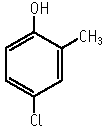

4-Chloro-o-cresol was not mutagenic to Salmonella typhimurium, TA100, TA1535, TA98, TA1537 and Escherichia coli WP2 uvrA. In the presence of an exogenous metabolic activation system, this chemical substance induced structural chromosomal aberrations in CHL/IU cells. Polyploidy was not induced under the conditions of the present study.
| Purity | : | 93.6% (Other contents : isomers, 3.3% ; cresol, 1.5%) |
| Test species/strain | : | Rat/Crj:CD (SD) |
| Test method | : | Guidelines for 28-Day Repeat Dose Toxicity Testing of Chemicals (Japan) |
| Route | : | Oral (gavage) |
| Doses | : | 0 (vehicle), 15, 60, 250, 1000 mg/kg/day |
| Number of animals/group | : | Males, 5 or 10 (0 and 1000 mg/kg/day) Females, 5 or 10 (0 and 1000 mg/kg/day) |
| Vehicle | : | Sesami oil |
| Administration period | : | Males and females, 28 days |
| Terminal kill | : | Males and females, days 29 or 43 |
| GLP | : | Yes |
Test results:
| Purity | : | 93.9% |
| Test species/strains | : | S.typhimurium TA100, TA1535, TA98, TA1537, Escherichia coli WP2 uvrA |
| Test methods | : | OECD guidelines (No. 471, 472) and Guidelines for Screening Mutagenicity Testing of Chemicals (Japan) |
| Procedures | : | Pre-incubation method |
| Solvent | : | DMSO |
| Positive controls | : | -S9 mix, AF-2 (TA100, TA98), sodium azide (TA1535), ENNG (WP2 uvrA) and 9-aminoacridine (TA1537) +S9 mix, 2-aminoanthracene (all strains) |
| Doses | : | -S9 mix: 19.5, 39.1, 78.1, 156, 313, 625, 1250 μg/plate (Salmonella strains) 39.1, 78.1, 156, 313, 625, 1250 μg/plate (WP2 uvrA) +S9 mix: 39.1, 78.1, 156, 313, 625, 1250 μg/plate |
| S9 | : | Rat liver, induced with phenobarbital and 5,6-benzoflavone |
| Plates/test | : | 3 |
| Number of replicates | : | 2 |
| GLP | : | Yes |
Test results:
| + | ? | - | |
| without metabolic activation | [ ] | [ ] | [*] |
| with metabolic activation | [ ] | [ ] | [*] |
| + | ? | - | |
| without metabolic activation | [ ] | [ ] | [*] |
| with metabolic activation | [ ] | [ ] | [*] |
| Purity | : | 93.9% |
| Type of cell used | : | Chinese hamster CHL/IU cells |
| Test method | : | OECD guideline (No. 473) and Guidelines for Screening Mutagenicity Testing of Chemicals (Japan) |
| Solvent | : | DMSO |
| Positive controls | : | -S9 mix, Mitomycin C +S9 mix, Benzo[a]pyrene |
| Doses | : | -S9 mix (24 h treatment): 0, 15, 30, 60 μg/ml -S9 mix (48 h treatment): 0, 5, 10, 20 μg/ml -S9 mix (6 h pulse treatment): 0, 31.3, 62.5, 125 μg/ml +S9 mix (6 h pulse treatment): 0, 20, 40, 80, 120 μg/ml |
| S-9 | : | Rat liver, induced with phenobarbital and 5,6-benzoflavone |
| Plates/test | : | 2 |
| GLP | : | Yes |
Test results:
| clastogenicity | polyploidy | |||||
| + | ? | - | + | ? | - | |
| without metabolic activation: | [ ] | [ ] | [*] | [ ] | [ ] | [*] |
| with metabolic activation: | [*] | [ ] | [ ] | [ ] | [ ] | [*] |
| 1) | The tests were performed by the Research Institute for Animal Science in Biochemistry and Toxicology, 3-7-11 Hashimotodai, Sagamihara-shi, Kanagawa 229, Japan. Tel +81-427-62-2775 Fax +81-427-62-7979 |
| 2) | The tests were performed by the Mitsubishi Chemical Safety Institute Ltd., 14 Sunayama, Hasaki-machi, Kashima-gun, Ibaraki, 314-02, Japan. Tel +81-479-46-2871 Fax +81-479-46-2874 |